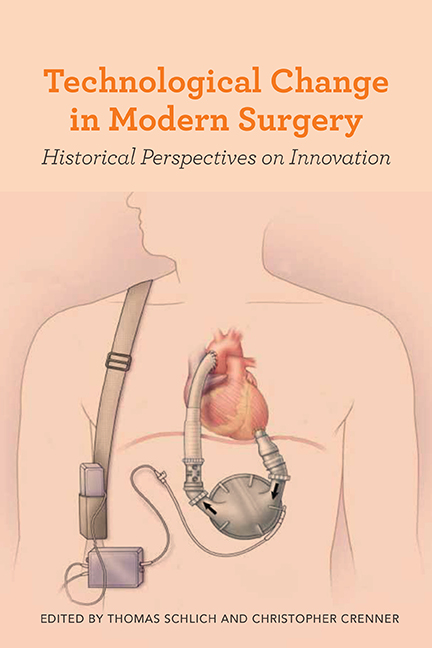Book contents
- Frontmatter
- Dedication
- Contents
- 1 Technological Change in Surgery: An Introductory Essay
- 2 Inimitable Innovation: Johann Friedrich Dieffenbach and the Renewal of Surgery, 1822–1847
- 3 Defining Difference: Competing Forms of Ovarian Surgery in the Nineteenth Century
- 4 “Making Bad Boys Good”: Brain Surgery and the Juvenile Court in Progressive Era America
- 5 Prosthetic Imaginaries: Spinal Surgery and Innovation from the Patient's Perspective
- 6 Disruptive Potential: The “Landmark” REMATCH Trial, Left Ventricular Assist Device (LVAD) Technology, and the Surgical Treatment of Heart Failure in the United States
- 7 Placebos and the Progress of Surgery
- 8 Surgical Practice and the Reconstruction of the Therapeutic Niche: The Case of Myocardial Revascularization
- Bibliography of Secondary Sources
- List of Contributors
- Index
6 - Disruptive Potential: The “Landmark” REMATCH Trial, Left Ventricular Assist Device (LVAD) Technology, and the Surgical Treatment of Heart Failure in the United States
Published online by Cambridge University Press: 09 June 2021
- Frontmatter
- Dedication
- Contents
- 1 Technological Change in Surgery: An Introductory Essay
- 2 Inimitable Innovation: Johann Friedrich Dieffenbach and the Renewal of Surgery, 1822–1847
- 3 Defining Difference: Competing Forms of Ovarian Surgery in the Nineteenth Century
- 4 “Making Bad Boys Good”: Brain Surgery and the Juvenile Court in Progressive Era America
- 5 Prosthetic Imaginaries: Spinal Surgery and Innovation from the Patient's Perspective
- 6 Disruptive Potential: The “Landmark” REMATCH Trial, Left Ventricular Assist Device (LVAD) Technology, and the Surgical Treatment of Heart Failure in the United States
- 7 Placebos and the Progress of Surgery
- 8 Surgical Practice and the Reconstruction of the Therapeutic Niche: The Case of Myocardial Revascularization
- Bibliography of Secondary Sources
- List of Contributors
- Index
Summary
“The [REMATCH] trial was analogous to randomizing Titanic patients to a lifeboat or the sea.”
—Cardiac surgeon Stephen WestabyHeart failure is a progressive, life-threatening condition that affects an estimated twenty-six million people worldwide, including 5.8 million Americans. For the patient in heart failure, their heart is simply not pumping blood as it should, and most die within five years after diagnosis owing to complications arising from poor or inadequate blood flow (such as organ failure) or from contracting infections in their weakened condition (such as pneumonia). The problem may be a case of left-sided heart failure (most common), right-sided heart failure, or both. The heartfailure patient may feel extreme fatigue, a shortness of breath, and possibly an increased heart rate, which will make everyday activities like walking and climbing stairs increasingly difficult. As the condition worsens, the patient experiences a buildup of fluid in the feet, ankles, and legs (edema), a congestion of blood in the lungs, perhaps memory problems, and even impaired thinking. There is no cure for heart failure. As one physician commented, “Heart failure is a lethal disease with a worse life expectancy than many types of cancer.”
In the United States, heart failure is among the most costly cardiovascular disorders owing to its intensive use of medical resources, including lengthy hospital stays and expensive medications. The number of new cases of heart failure increases with patient age, and with the rising number of elderly people in the United States, a greater proportion of the American population suffers from heart failure each decade. In 2013, the direct and indirect costs of caring for the heart-failure patient in the United States, including hospitalization and medications, is about $31 billion, and this number is expected to more than double by 2030. More people are surviving heart attacks and other cardiac conditions, perhaps because of more successful therapies or better education about heart disease. This means that people are living longer with damaged hearts and thus carry the risk of heart failure. To be clear, mortality rates from coronary heart disease have been declining since the 1960s yet it still remains the leading cause of death in many developed countries.
- Type
- Chapter
- Information
- Technological Change in Modern SurgeryHistorical Perspectives on Innovation, pp. 129 - 155Publisher: Boydell & BrewerPrint publication year: 2017



